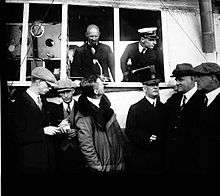William A. Moffett
| William Adger Moffett | |
|---|---|
 Rear Admiral William A. Moffett | |
| Born |
October 31, 1869 Charleston, South Carolina, U.S. |
| Died |
April 4, 1933 (aged 63) off the coast of New Jersey, U.S. |
| Place of burial | Arlington National Cemetery |
| Allegiance |
|
| Service/branch |
|
| Years of service | 1890 – 1933 |
| Rank |
|
| Commands held |
USS Chester (CL-1) Great Lakes Naval Training Center USS Mississippi (BB-41) Bureau of Aeronautics |
| Battles/wars |
Spanish–American War *Capture of Guam *Battle of Manila (1898) Mexican Revolution *Battle of Veracruz World War I |
| Awards |
Medal of Honor Navy Distinguished Service Medal |
William Adger Moffett (October 31, 1869 – April 4, 1933) was an American admiral and Medal of Honor recipient known as the architect of naval aviation in the United States Navy.
Biography

Born October 31, 1869 in Charleston, South Carolina, he graduated from the United States Naval Academy in 1890. He was the son of George Hall Moffett (1829–1875), who enlisted in the Confederate States army as a private, and was promoted for bravery on the field of battle, eventually attaining the rank of Captain and adjutant-general, Hagood's Brigade, Twenty-fifth South Carolina Volunteers.
Moffett was on USS Charleston (C-2) when she sailed across the Pacific and captured Guam. Ultimately ending up in the Philippines, a month after the US victory at Manila Bay. The USS Charleston then shelled enemy positions in support of American and Filipino troops at the Battle of Manila (1898).
In December 1915 Moffett received the Medal of Honor for his captaincy of the USS Chester in a daring and dangerous night landing in 1914 at Veracruz, Veracruz, Mexico. (See also United States occupation of Veracruz, 1914). (See text of the Citation set forth below.)
In World War I, he was commander of the Great Lakes Naval Training Center near Chicago, and there established an aviator training program. While commanding the battleship USS Mississippi (1918–1921) he supported the creation of a scout plane unit on the ship.
Although not himself a flyer, Moffett became known as the "Air Admiral" for his leadership of the Navy's Bureau of Aeronautics from its creation in 1921 with CAPT Henry C. Mustin as its first Assistant Chief. In this role, he oversaw the development of tactics for naval aircraft, the introduction of the aircraft carrier,[1] and relations with the civilian aircraft industry. A master politician, he maintained official support for naval aviation against Billy Mitchell, who favored putting all military aircraft into a separate air force. In that regard, Moffett benefited from his longstanding friendship with Franklin D. Roosevelt, who had been appointed Assistant Secretary of the Navy by Woodrow Wilson in 1913.
Moffett was also an advocate of the development of lighter-than-air airships, or "dirigibles."
He lost his life on the USS Akron when that airship, which was then the largest dirigible in the world, went down in a storm off the coast of New Jersey on April 4, 1933.
He is buried in Arlington National Cemetery, alongside his wife Jeanette Whitton Moffett. One of their three sons, William Adger Moffett, Jr., was also a Navy admiral; he died in 2001, and is also buried in Arlington Cemetery.
Decorations
Rear Admiral's Moffett's decorations included: Medal of Honor, Navy Distinguished Service Medal, Philippine Campaign Medal, Lifesaving Medal, Mexican Service Medal, Navy Spanish Campaign Medal, World War I Victory Medal and Naval Aviation Observer wings.
 | |||
Medal of Honor citation
Rank and organization: Commander, U.S. Navy. Entered service at: Charleston, South Carolina Born: 31 October 1869, Charleston, South Carolina G.O. No.: 177, 4 December 1915. Other Navy award: Distinguished Service Medal.
Citation:
For distinguished conduct in battle, engagements of Vera Cruz, 21 and 22 April 1914. Comdr. Moffett brought his ship into the inner harbor during the nights of the 21st and 22d [2] without the assistance of a pilot or navigational lights, and was in a position on the morning of the 22d to use his guns at a critical time with telling effect. His skill in mooring his ship at night was especially noticeable. He placed her nearest to the enemy and did most of the firing and received most of the hits.
Namesake
- The USS Moffett (DD-362) was named for him.
- The naval air station that he helped establish in Sunnyvale, California was renamed Moffett Field in his memory soon after his death.
- Mount Moffett, a mountain in Alaska.
- John Philip Sousa's march, "The Aviators" is dedicated to William J. Moffett, the man responsible for Sousa's commission in the American Navy during World War I.[3]
- In May 1999, NAVAIR, dedicated its headquarters building to William A. Moffett.
See also
- List of Medal of Honor recipients (Veracruz)
- Bureau of Aeronautics
- Naval aviation
- U.S. Occupation of Veracruz, Mexico, 1914
Notes
- ↑ Regarding the "Flying Deck Cruiser":
See Youtube video "Military Innovations: Naval Innovation in the Interwar Period".
https://www.youtube.com/watch?v=Uz7DcC3Brp8
It's a lecture by Dr. Kuehn at the Dole Institute of Politics. At roughly 41 minutes into (the 1:05 total length), there is a discussion of how Moffett promoted the angle decked "Flying Deck Cruiser" in circa 1932 (until ~1939), but failed due to budget restraints. - ↑ sic: it must have been one single night, around midnight of 21-22
- ↑ http://www.medinacommunityband.org/july-4--2009
References
- Edward Arpee, From Frigates to Flat-tops: The story of the life and achievements of Rear Admiral William Adger Moffett, U.S.N. "The Father of Naval Aviation" October 31, 1869-April 4, 1933. (Published and distributed by the author, 1953).
- William F. Trimble, Admiral William A. Moffett: Architect of Naval Aviation (Washington, D.C.: Smithsonian Institution Press, 1994)
External links
- "Moffett bio at Arlington Cemetery".
- "William A. Moffett". Claim to Fame: Medal of Honor recipients. Find a Grave. Retrieved 2007-12-12.